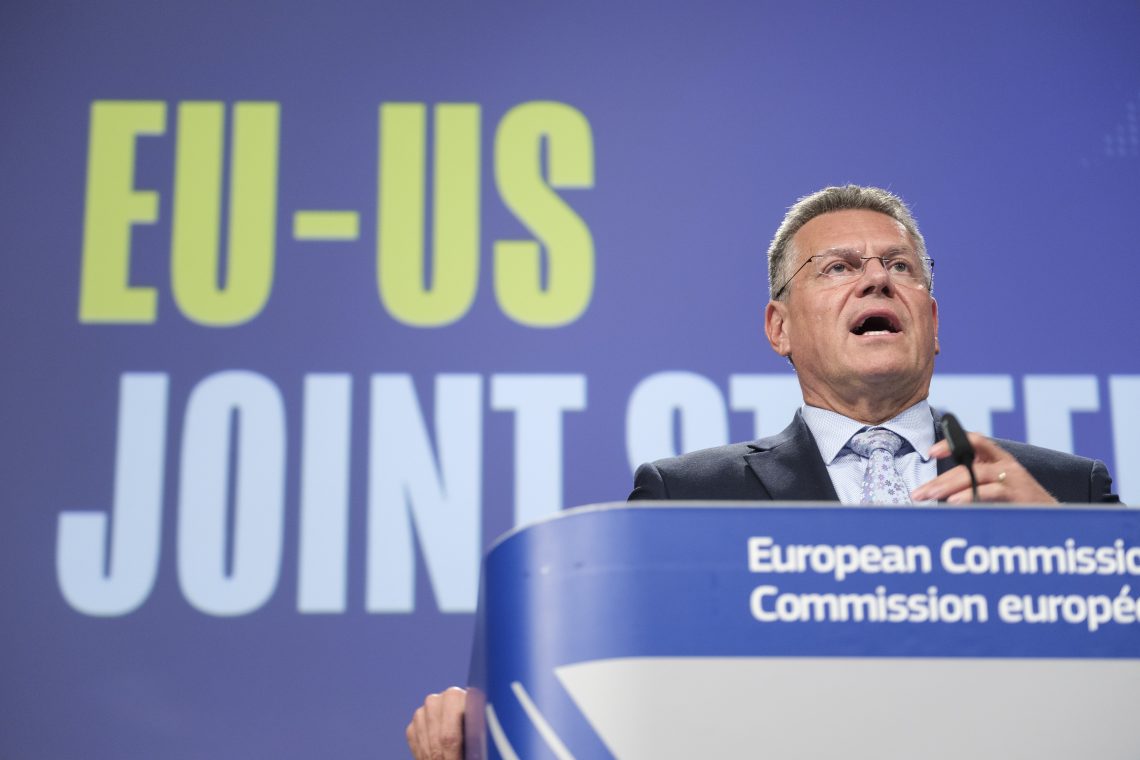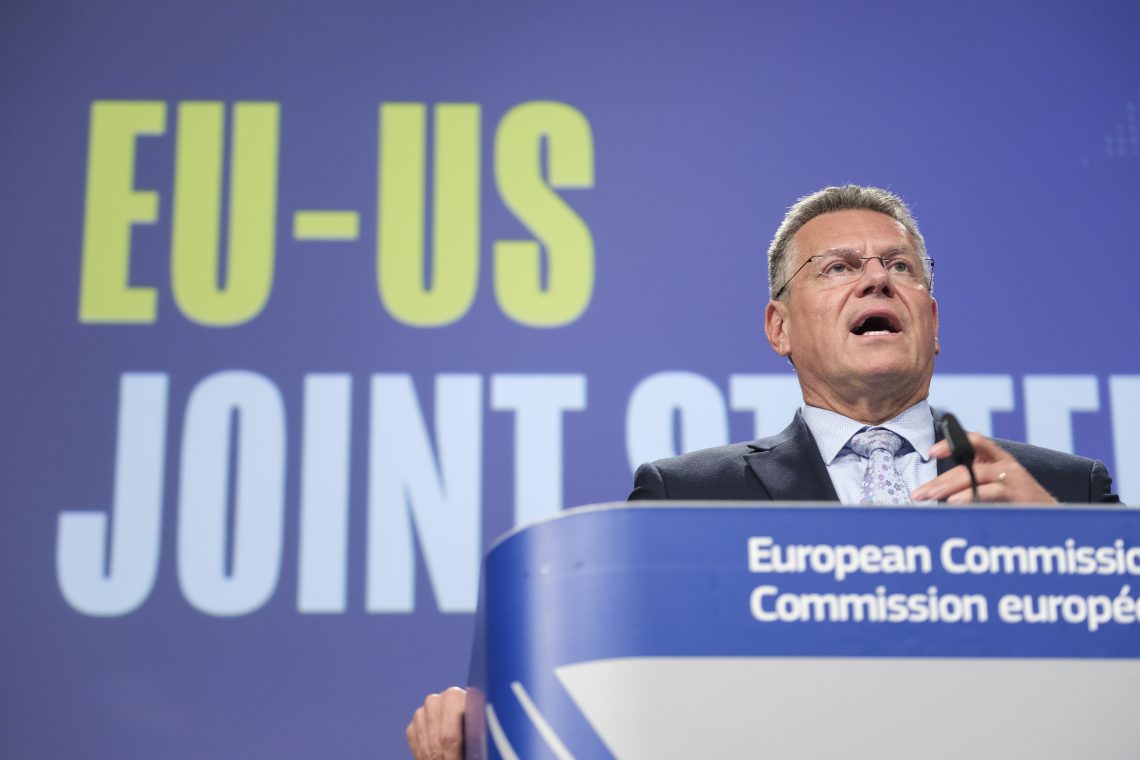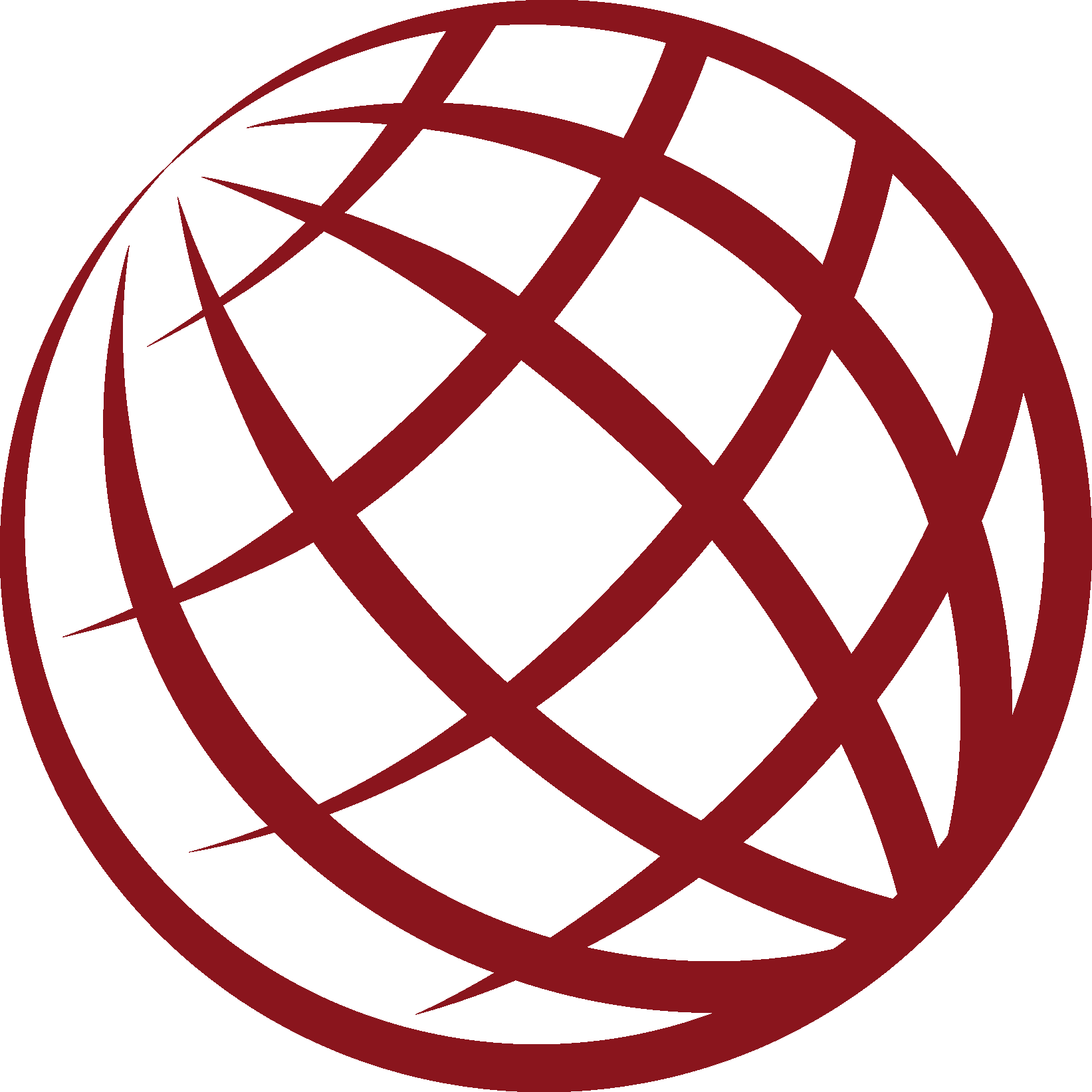As Brussels caves to the Trump administration’s demands, the new agreement may compel Global Majority countries to reassess their alignments.
 Brussels, Belgium, Aug. 21: European Trade Commissioner Maros Sefcovic said that as part of their trade agreement, the EU and U.S. are working on a “metals alliance” to counter the effects of subsidized Chinese production on global markets. © Getty Images
Brussels, Belgium, Aug. 21: European Trade Commissioner Maros Sefcovic said that as part of their trade agreement, the EU and U.S. are working on a “metals alliance” to counter the effects of subsidized Chinese production on global markets. © Getty Images
The Global Majority faces rising protectionism from the U.S.-EU alliance
The trade deal fortifies transatlantic control of new technology
ESG concessions favor U.S. firms over those from emerging countries
This is part 2 of GIS’s two-report series on the U.S.-EU trade deal. Part 1 is available here.
In August, the United States and the European Union signed a landmark trade agreement. “The Framework on an Agreement on Reciprocal, Fair and Balanced Trade” builds on previous official statements regarding the U.S.-EU trade deal and seeks to strengthen the trade and investment relationship as a first step.
The deal prompted varied reactions across Europe, most notably from Mario Draghi, former European Central Bank president and former Italian prime minister, who issued a stern warning about the bloc’s declining geopolitical relevance. He described the agreement as emblematic of Europe’s failure to translate economic size into global influence, exposing structural flaws and the need for urgent institutional reform.
European Commission President Ursula von der Leyen defended the deal as a pragmatic and necessary compromise, calling it a “good, if not perfect” outcome that averted a potentially devastating trade war. She emphasized that maintaining cohesion with Washington was crucial, especially amid rising authoritarian influence from Moscow and Beijing.
Not all European capitals shared this optimism. Former French Prime Minister Francois Bayrou called the deal a capitulation to U.S. pressure and a “dark day” for European autonomy. German Chancellor Friedrich Merz warned of inflation risks and competitive imbalances. German business groups contended that Brussels had failed to protect key European industries and regulatory standards.
For non-EU countries, the deal’s implications are profound. It signals a growing preference among major powers for bilateral trade agreements over multilateral ones, potentially marginalizing smaller or less developed economies that rely on World Trade Organization (WTO) mechanisms. The deal’s substantial investment commitments and energy contracts could divert capital and trade flows from countries outside the transatlantic corridor, particularly from emerging countries making up the Global Majority.
Strategically, this deal bolsters a Western economic bloc amid increasing geopolitical fragmentation, prompting many non-Western countries to reconsider their alignments in a world increasingly shaped by regional power centers rather than global consensus.
Ring-fencing steel and aluminum
The framework agreement proposes coordinated protection of the U.S. and EU domestic steel and aluminum markets through what EU Trade Commissioner Maros Sefcovic described as a joint “metals alliance.” This alliance aims to mitigate the adverse effects of subsidized overproduction, primarily from China, by establishing tariff rate quotas at unprecedented levels and easing reciprocal trade between Europe and America. However, it may also exclude or restrict access for other third countries.
This deal bolsters a Western economic bloc amid increasing geopolitical fragmentation, prompting many non-Western countries to reconsider their alignments.
Countries in the Global Majority, long integral to international metal supply chains as exporters of raw metals or intermediate goods, now face heightened vulnerability. As the EU and U.S. collaborate to exclude “disruptively cheap” imports, suppliers from regions across Southeast Asia, Latin America, Africa and South Asia may find their traditional markets closed or less accessible. Producers in emerging countries risk being caught between low-priced Chinese overcapacity and the preferential bilateral quotas granted to industries in Europe and America.
This realignment may force nations in the Global Majority into a strategic dilemma: Should they align with the U.S.-EU bloc to maintain market access, or seek alternative markets, perhaps through new regional blocs or Beijing, to sustain their export markets?
Rules of origin
Rules of origin determine whether a product qualifies for preferential treatment under a trade agreement. The trade deal includes a rule to ensure the benefits of the transatlantic trade agreement remain largely within the U.S. and the EU, making it harder for other countries to compete. These “rules of origin” act like barriers, limiting developing nations’ ability to sell their goods in these markets.
This dynamic undermines the inclusiveness of the multilateral trade system. By favoring internal supply chains and largely excluding third-party economies, the pact departs from the open, non-discriminatory trade framework endorsed by the WTO and multilateral trade standards. This segmentation widens economic inequalities and could push developing economies to join alternative trade blocs or adopt more regional or fragmented trade approaches.
Key terms of the U.S.-EU agreement
The EU will purchase $750 billion in U.S. energy and make new investments of $600 billion in America, all by 2028.
The U.S. and EU plan to work together to address non-tariff barriers affecting trade in food and agricultural products.
America and Europe will set strict rules of origin to ensure the benefits of this agreement go directly to the U.S. and EU, not third countries.
The U.S. and EU intend to eliminate unjustified digital trade barriers.
The two sides will coordinate actions on non-market policies of third parties, and cooperate on investment reviews, export controls and duty evasion.
The EU has agreed to purchase significant amounts of American military equipment.
U.S.-EU technology convergence
By committing to aligning technology security requirements with those of the U.S. to prevent technology leakage to “destinations of concern,” the framework agreement strengthens transatlantic control over strategic technologies and alters the competitive landscape. In operational terms, the agreement introduces stricter export controls, joint oversight of sensitive sectors such as semiconductors, artificial intelligence, quantum computing and biotechnology, and coordination of licensing systems focused on compliance with U.S.-aligned security standards. For third countries, these measures erect barriers to participation in global high-tech value chains.
Emerging markets often rely on importing advanced inputs and exporting components or assembled products. As the U.S. and EU tighten their standards through shared technology security requirements, exporters from the Global Majority could face higher compliance costs and increased paperwork. This may force these countries to depend on the goodwill or policy differences of other major powers. Such disparities could lead to increased fragmentation in global standards, data governance and technology transfer norms.
Critical minerals trade strategy
The U.S. and EU pledge to coordinate responses to export restrictions on critical minerals by third countries marks a major shift in global resource governance. This could substantially affect opportunities for resource-rich developing economies. By aligning their strategies, Washington and Brussels are forming a collective front to secure access to essential raw materials.
Resource-rich emerging countries may face mounting external pressure to manage how and to whom they export their critical minerals. If the U.S. and EU implement punitive or retaliatory measures, such as sanctions or trade restrictions, against countries that impose export limits, this could deter sovereign decisions to prioritize domestic industrialization over export restrictions.
Furthermore, the absence of multilateral mechanisms for managing strategic resource flows, such as a proposed International Materials Agency, limits the options of developing countries for jointly and transparently protecting their interests.
More by trade and sanctions expert Bob Savic
Economic security alignment and supply chain resilience
As the U.S. and EU deepen their economic security cooperation through coordinated actions targeting non-market policies (government or institutional interventions), investment screenings, export controls, duty evasion and mutual access to government contracts, they are building a fortified transatlantic economic framework. This not only boosts supply chain resilience and fosters innovation but also effectively excludes participants from third countries.
By harmonizing foreign investment reviews, the U.S.-EU bloc’s proposals for outbound investment screening could limit developing economies’ access to capital from U.S. or EU investors, particularly for ventures in technology, raw materials or dual-use industries. This redirects investment flows that previously supported growth and industrialization.
The framing of “non-market” practices, like state subsidies, as targets of joint U.S.-EU countermeasures also has indirect effects. Governments in the Global Majority that rely on industrial policies, subsidized sectors or significant state-owned enterprises may face suspicion or punitive responses, potentially leading to higher tariffs or sanctions. Even when such policies are domestically justified, they may provoke retaliation or exclusion from procurement tenders and supply partnerships.
Standards for environmental and social governance
The framework agreement’s provisions on the eurozone’s environmental and social governance and corporate social responsibility norms create a de facto carve-out favoring American businesses that lowers their trade costs and enhances competitiveness in EU markets. Meanwhile, companies from the Global Majority face higher compliance costs, administrative burdens and market access barriers. The EU’s carve-out for U.S. producers concerning its deforestation regulation strengthens Washington’s influence over global commodity supply chains and standards.
The deal’s provisions on the Carbon Border Adjustment Mechanism aim to address the White House’s concerns about burdens on small and medium-sized enterprises. By committing to “additional flexibilities” beyond already elevated de minimis thresholds, the EU facilitates easier U.S. exports to Europe under the carbon levy regime. This preferential treatment stands in contrast to the likely tougher consequences for emerging economies, which may lack access to similar regulatory flexibilities and could incur prohibitive costs.
The agreement’s commitment to protecting labor rights and eliminating forced labor in supply chains is ethically positive but also geopolitically charged. The U.S.-EU tandem’s leadership in setting such standards could translate into stricter enforcement rules that disproportionately affect Global Majority suppliers, where labor conditions are often more precarious. Such regulations may become trade barriers if applied unevenly or without adequate capacity-building support.
Scenarios
More likely: Fragmented adaptation with regional blocs and selective alliances
Global Majority countries will respond to the framework agreement through regional coalitions and selective partnerships with Western or non-Western powers, rather than as a unified bloc. Countries with institutional capacity and regulatory flexibility, such as Brazil, India, Indonesia and South Africa, may seek to diversify their trade strategies. This could involve pursuing preferential agreements with the U.S. or the EU individually, selectively aligning with digital or environmental standards, or advocating for inclusion in transatlantic supply chains where possible. Others may deepen ties with China, the Gulf states or regional blocs like the Association of Southeast Asian Nations and the African Continental Free Trade Area to offset exclusion from Western supply networks.
Regarding critical minerals, countries such as Zambia, Namibia and the Democratic Republic of the Congo may look to establish new bilateral or trilateral partnerships. This strategy would enable them to retain influence over resource policies while securing investments, whether from Western nations through initiatives such as the transnational Minerals Security Partnership or from Chinese state-owned enterprises. In technology and export controls, some may seek to comply with Western norms where possible but otherwise collaborate with alternative players for investment in digital infrastructure or AI research and development.
Nevertheless, this response would remain uneven and constrained by institutional and financial limitations, making it more defensive than transformative. The resulting landscape would feature multipolar trade alignments and geoeconomic hedging, with countries striving to balance autonomy, growth and inclusion within overlapping systems.
Somewhat likely: Coordinated South-South advocacy and rulemaking
The Global Majority will attempt to unite diplomatically to resist exclusionary practices stemming from the U.S.-EU agreement by pushing for multilateral rulemaking or creating new South-South economic structures.
This could include coordinated efforts at the WTO, UN Trade and Development or the G77 to challenge rules of origin, investment screening criteria and technology export controls as discriminatory or contrary to development goals. Countries may also promote the creation of new institutions to establish a rules-based framework that counters the fragmentation caused by exclusive Western alignment.
Within this scenario, BRICS+ could serve as a platform for a joint strategy on mineral sovereignty, investment facilitation and procurement reciprocity. Initiatives like the Belt and Road Initiative, the China-Arab Cooperation Forum or the African Union’s Agenda 2063 could be used as counterweights to transatlantic standards.
However, fragmented South-South trust and resource disparities would limit the ability to execute such a coordinated response on a large scale.
Unlikely: Full strategic unity against the U.S.-EU bloc
Countries in the Global Majority form a unified economic alliance explicitly in opposition to the trade and security framework established by the U.S. and EU. As frustrations grow over inequities in global trade and technology governance, developing countries cease to engage deeply with both Europe and America.
Many emerging economies stop depending on Western financial systems, such as dollar-denominated markets and SWIFT. Instead, they create their own digital infrastructure, including cloud platforms and telecom equipment, along with regulatory validations like food and industrial standards.
An adversarial bloc formation could also lead to the creation or elevation of existing multilateral institutions focused on concessional lending for the Global Majority.
While full-scale strategic realignment away from Western systems and toward a unified South-South bloc is not economically feasible in the near to medium term, it may emerge over the longer run.
Contact us today for tailored geopolitical insights and industry-specific advisory services.

